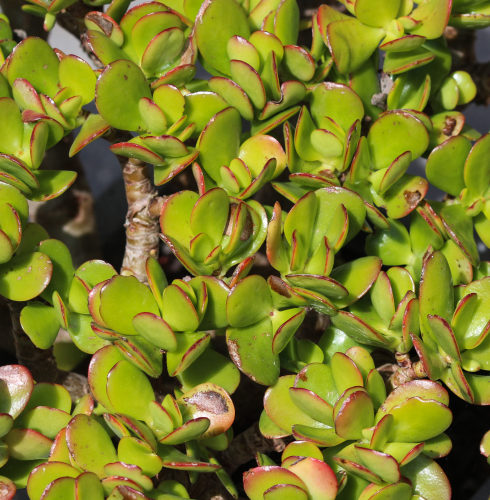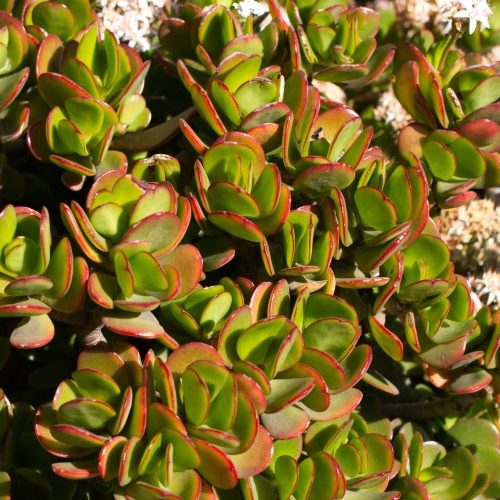
Crassula ovata
The Crassula ovata, often celebrated as the Jade Plant, is a beloved succulent renowned for its striking appearance and symbolic significance. This resilient plant is admired for its lush, glossy leaves that are rich in color and thick in texture, resembling precious jade stones.
Zones: 10a - 12b
Sun, Bright Shade
Well-Drained, Rich, Gritty
Winter
Drought Tolerant, Dry in Between Watering
Indoors, Outdoors
Seed, Cuttings
Cats, Dogs
ALso Known AS
Jade Plant, Jade Tree, Money Tree, Money Plant, Dollar Plant, Japanese Rubber, Friendship Tree, Lucky Plant, Baby Jade
Origin
South Africa
leaf shape
Thick, glossy, and oval-shaped, resembling jade stones.
difficulty
Great for Beginners
Crassula ovata is also known as jade plant are one of the most popular succulents because they are easy to care for and to propagate. This succulent is an ideal choice for beginners.
The leaves of Crassula ovata are oval shaped and a bright jade green. Some varieties develop red edges when exposed to bright sunlight. They grow in small to medium-sized shrubs or trees in their natural habitat of South Africa. Crassula ovata stems are thick and grey-green. The stems become woody with age and its bark peels in horizontal strips. They can grow to be 2 to 4 feet in height once mature.
Water Needs
Prefers to be dry in between watering. Crassula ovata is drought tolerant and can go long periods without water.
TEMPERATURE / Hardiness
Zones: 10a - 12b
Needs protection from the cold. Bring indoors once weather drops below 50°f.
Light
Crassula ovata grows well indoors if given adequate light. Shield from the intense sun when outdoors.
dormancy
Size
In a typical indoor setting, a Jade Plant can reach heights of 2 to 4 feet (60 to 120 centimeters), but it has the potential to grow taller over many years. In terms of width, it often matches its height, forming a rounded, tree-like shape as it matures.
Toxicity
CatsDogsCrassula ovata is toxic to horses and toxic to humans. It can cause skin irritation and digestive symptoms. Animals may exhibit excessive drooling, weakness, and lethargy.
flowers
WinterUnder the right conditions, Crassula ovata produces flowers during colder months. The flowers are star-shaped and pink tinged white and grow in ball shaped clusters. Crassula ovata ‘Pink Beauty’ produces pink flowers.
Soil
Jade plants can stay in the same container for years. Repot if it becomes root bound or to refresh the soil.
Feeding
Fertilize sparingly in spring and summer; avoid overfeeding.



how do you propagate Crassula ovata?
propagated from:
SeedCuttingsPropagates from leaves and stems. Remove a leaf or stem with a clean straight cut, leave to callous for a few days, then place in the soil until roots appear.
FAQ
Frequently asked questions about Crassula ovata

What is the ideal lighting for a Jade Plant?
Jade Plants thrive in bright, indirect sunlight. They can tolerate some direct sunlight, but too much can scorch their leaves. A south-facing window with filtered light is ideal. In low light conditions, they may become leggy and lose their vibrant color.

Can Jade Plants be grown outdoors?
Yes, Jade Plants can be grown outdoors in regions with mild, frost-free climates (USDA zones 10-11). They should be placed in a spot with partial sun exposure and protected from harsh midday sun and freezing.

Why are my Jade Plant's leaves falling off?
Leaf drop can be caused by overwatering, under watering, or a sudden change in the environment (like moving the plant to a new location). Assess your watering schedule and ensure the plant is in a stable environment with appropriate lighting.
Similar Topics in: Crassula, Crassulaceae